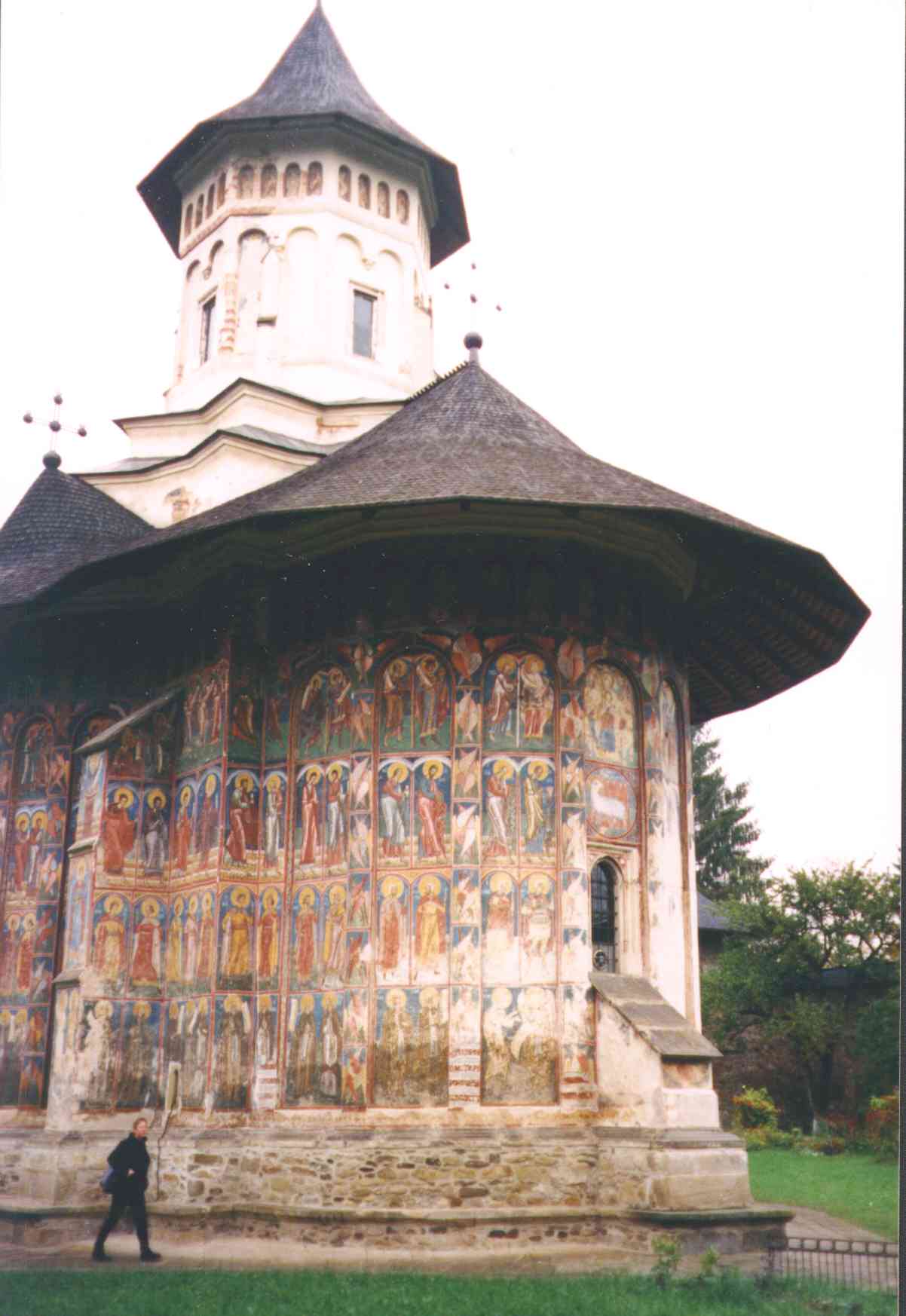 ART
OF THE FRESCO:
ART
OF THE FRESCO:| Home | Humor | Moldoviţa | Arbore | Voroneţ | Suceviţa |
| Link | Pictures | Pictures | Pictures | Pictures | Pictures |
This web site is designed for best viewing on a 800 x 600
true color display.
We have used multilingual UTF-8 charset for Romanian characters.
If "ţ" appears as a box
please enable multilanguage support on your computer.
A Bit of History
Development of Moldavian Style
General Description
Conservation
 ART
OF THE FRESCO:
ART
OF THE FRESCO:Caught between East and West, a Latin enclave surrounded by Slavs and Magyars, Romania suffered a devastating cold-war period yet remains a land of astonishing richness and beauty. We cannot forget Romania's desperate struggle to recover from disaster, but we can perhaps draw encouragement from the continued survival of her natural beauty and amazing architectural heritage. Greatest amongst her treasured buildings are the painted monasteries of Bucovina, which remain virtually unknown outside their own country yet stand unrivalled anywhere else on earth.
 Located on the northern border of Romania, Bucovina, part of the old
province of Moldavia, is a mountainous region whose peaks and forests of beech and pine
shelter gently sloping valleys. Here, during the short period of a quarter of a century,
between 1522 and 1547, a group of churches sprang up, frescoed with a liberality and
magnificence unparalleled in any other country. The painting of religious murals was
widely practiced throughout the Orthodox Church, for the edification of the illiterate
faithful who flocked to church on feast days, but here in Romania it achieved its finest
flowering. The painted monasteries are covered within and without in vivid, minutely
detailed frescoes whose colors remain fresh and strong. They have been compared to Persian
carpets or to jewels set in cases of green grass and flowers within their severe
enclosures. That they have survived to this day, despite the passage of time, wars,
invasions, and the vandalism of rival religions or ideologies, is little short of
miraculous.
Located on the northern border of Romania, Bucovina, part of the old
province of Moldavia, is a mountainous region whose peaks and forests of beech and pine
shelter gently sloping valleys. Here, during the short period of a quarter of a century,
between 1522 and 1547, a group of churches sprang up, frescoed with a liberality and
magnificence unparalleled in any other country. The painting of religious murals was
widely practiced throughout the Orthodox Church, for the edification of the illiterate
faithful who flocked to church on feast days, but here in Romania it achieved its finest
flowering. The painted monasteries are covered within and without in vivid, minutely
detailed frescoes whose colors remain fresh and strong. They have been compared to Persian
carpets or to jewels set in cases of green grass and flowers within their severe
enclosures. That they have survived to this day, despite the passage of time, wars,
invasions, and the vandalism of rival religions or ideologies, is little short of
miraculous.
For centuries Romania has been the last sentinel and first outpost against the Asiatic hordes that swept down on Europe. From the retreat of the Romans from Dacia in A.D. 271, barbarian conquerors poured out of the steppes of Central Asia on their way toward Rome or Byzantium. No unified government could rise in this prolonged period of anarchy. As the Tatar and Cuman invasions continued to ebb and flow, two principalities began to take shape in the thirteenth century: Moldavia and Wallachia, patchy kingdoms created by elected rulers who sometimes rose to greatness and always had to fight rivals or go to war against invaders. Their inhabitants remained an essentially agricultural and pastoral people who, in times of danger, retreated to the mountains only to return to the plains when they could.
After the fall of Constantinople in 1453, it was the Ottoman Empire that swept north in successive waves to its final standstill before the walls of Vienna in 1683. Patriotism and religious faith combined led the Moldavian ruler Stephen the Great to resist the Islamic tide during his long and glorious reign (1457-1504), but after his death decay set in and Moldavia was plunged in intrigues amid the territorial claims of Poland, Hungary, Austria and Turkey. In the summer of 1538, Suleiman the Magnificent overran Moldavia on his way to Hungary, and in 1541 he installed Stephen’s son, Petru Rareş, on the throne. For the rest of the century Moldavia underwent the degenerate rule of the puppets of the Ottoman Empire, who often bought their all-too-brief right to the throne. But it retained a degree of independence that nourished its art, leading to a blending of Byzantine, gothic and Italian influences.
| A nun beats a long beam with a mallet, tapping out a call to prayer. During their domination over Moldavia, the Turks had forbidden the ringing of bells, and the striking of wooden or metal bars, known a toacă, had been substituted and became a tradition -- reinforced by the fact that in times of war bells were often melted down to make cannons. |
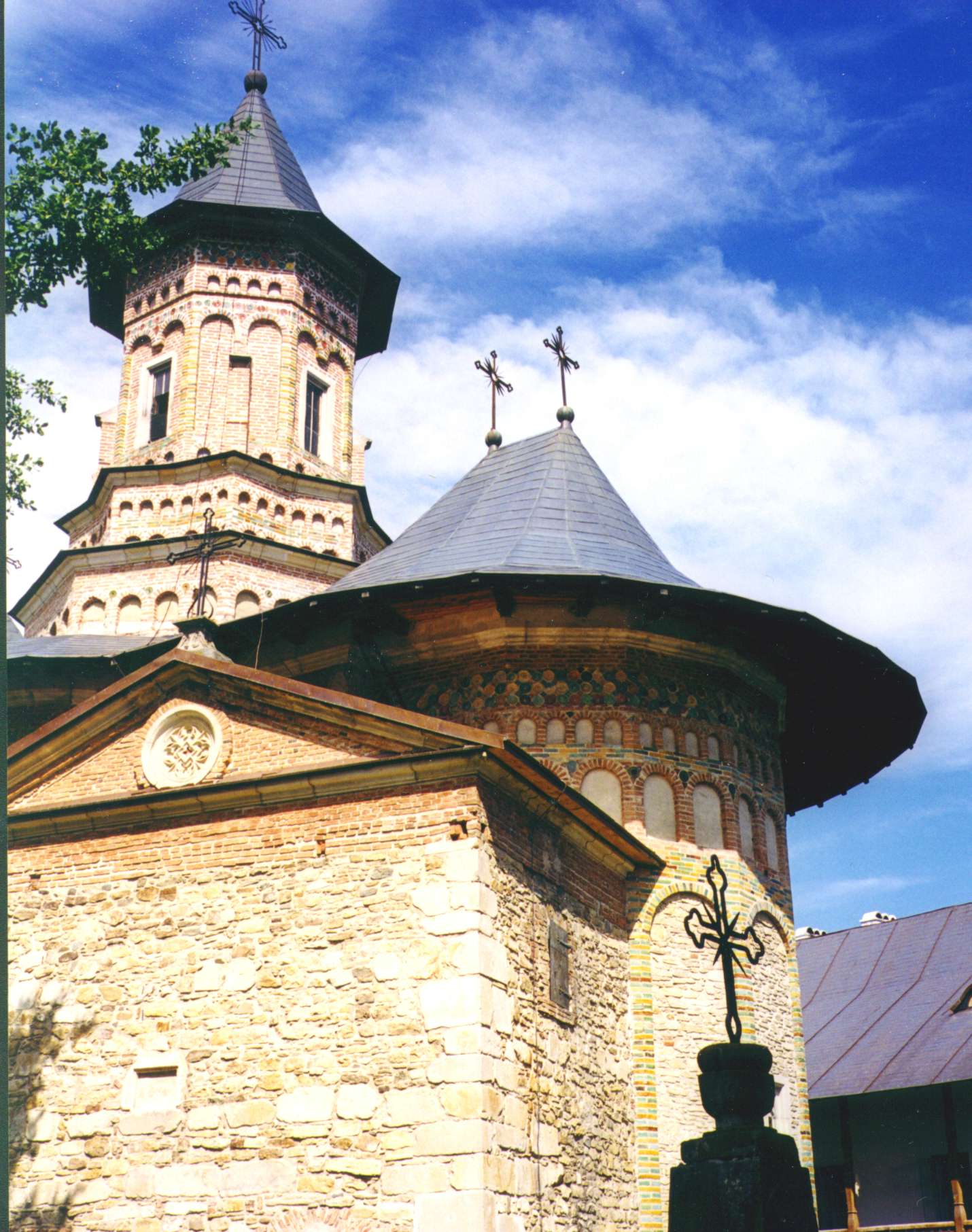 In
the second half of the fifteenth century, Stephen the Great built forty-four churches –
one after each of his victories over the Turks – that established the style of elegant
octagonal steeples raised on a tall star-shaped base. In his time, monasteries were
decorated with enameled disks and colored bricks placed around the steeple, below
the cornice, and along architectural elements. There are indications that even then,
masons
In
the second half of the fifteenth century, Stephen the Great built forty-four churches –
one after each of his victories over the Turks – that established the style of elegant
octagonal steeples raised on a tall star-shaped base. In his time, monasteries were
decorated with enameled disks and colored bricks placed around the steeple, below
the cornice, and along architectural elements. There are indications that even then,
masons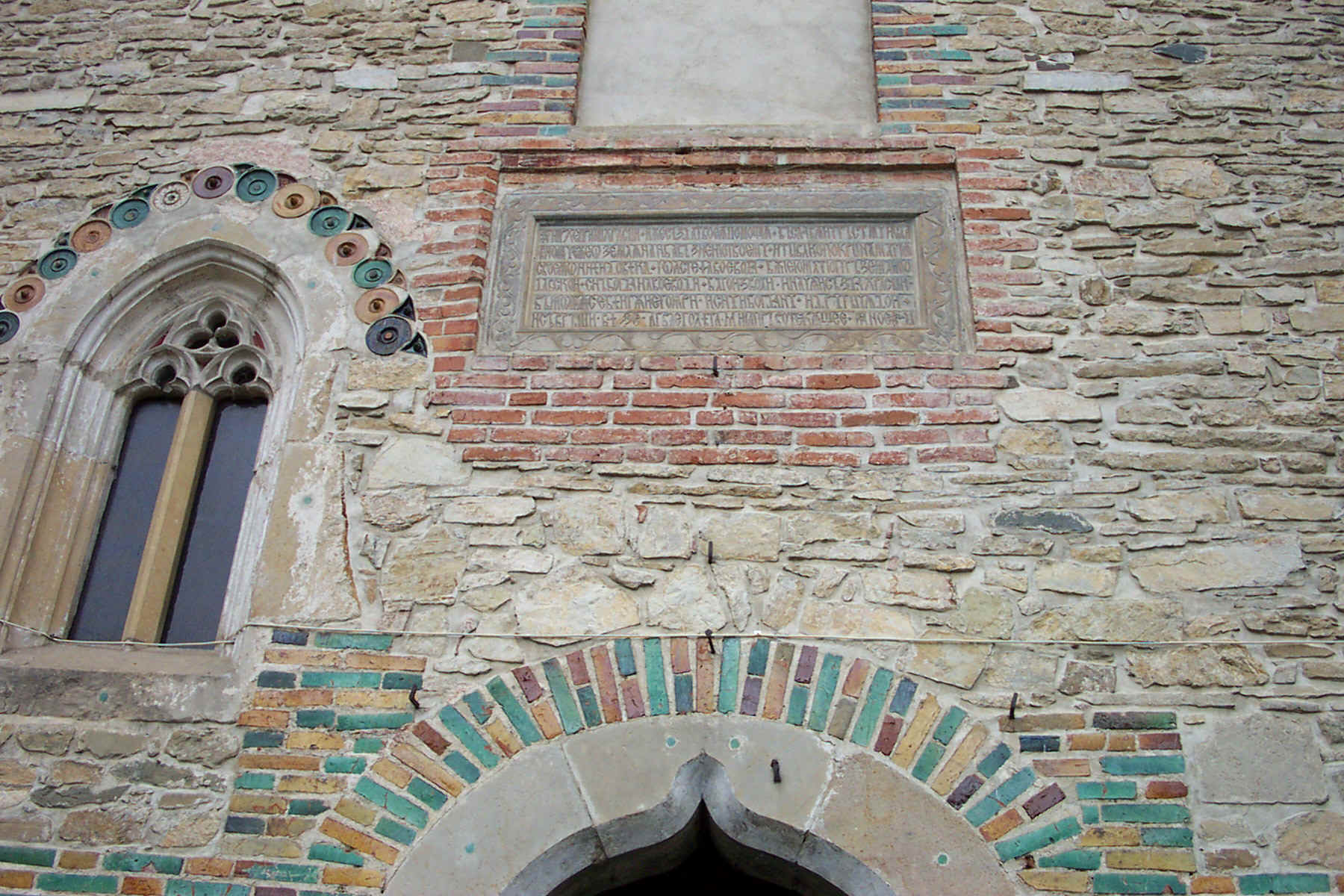 familiar with the technique of fresco
painted colored bricks on the parts of the facades that were not adorned with glazed
bricks. The idea of extending the figurative interior painting to the exterior surface of
the walls may have originated in this practice, although the paintings in the open
galleries of many medieval Byzantine churches in Greece, Serbia and Bulgaria do
already spread somewhat to the outside walls.
familiar with the technique of fresco
painted colored bricks on the parts of the facades that were not adorned with glazed
bricks. The idea of extending the figurative interior painting to the exterior surface of
the walls may have originated in this practice, although the paintings in the open
galleries of many medieval Byzantine churches in Greece, Serbia and Bulgaria do
already spread somewhat to the outside walls.
Monasticism was always supreme in the Eastern Church. The rulers and rich families of
the two Romanian Principalities continued the tradition of erecting churches and religious
buildings. They endowed the monasteries with land, forests, vineyards, orchards and
villages, and would 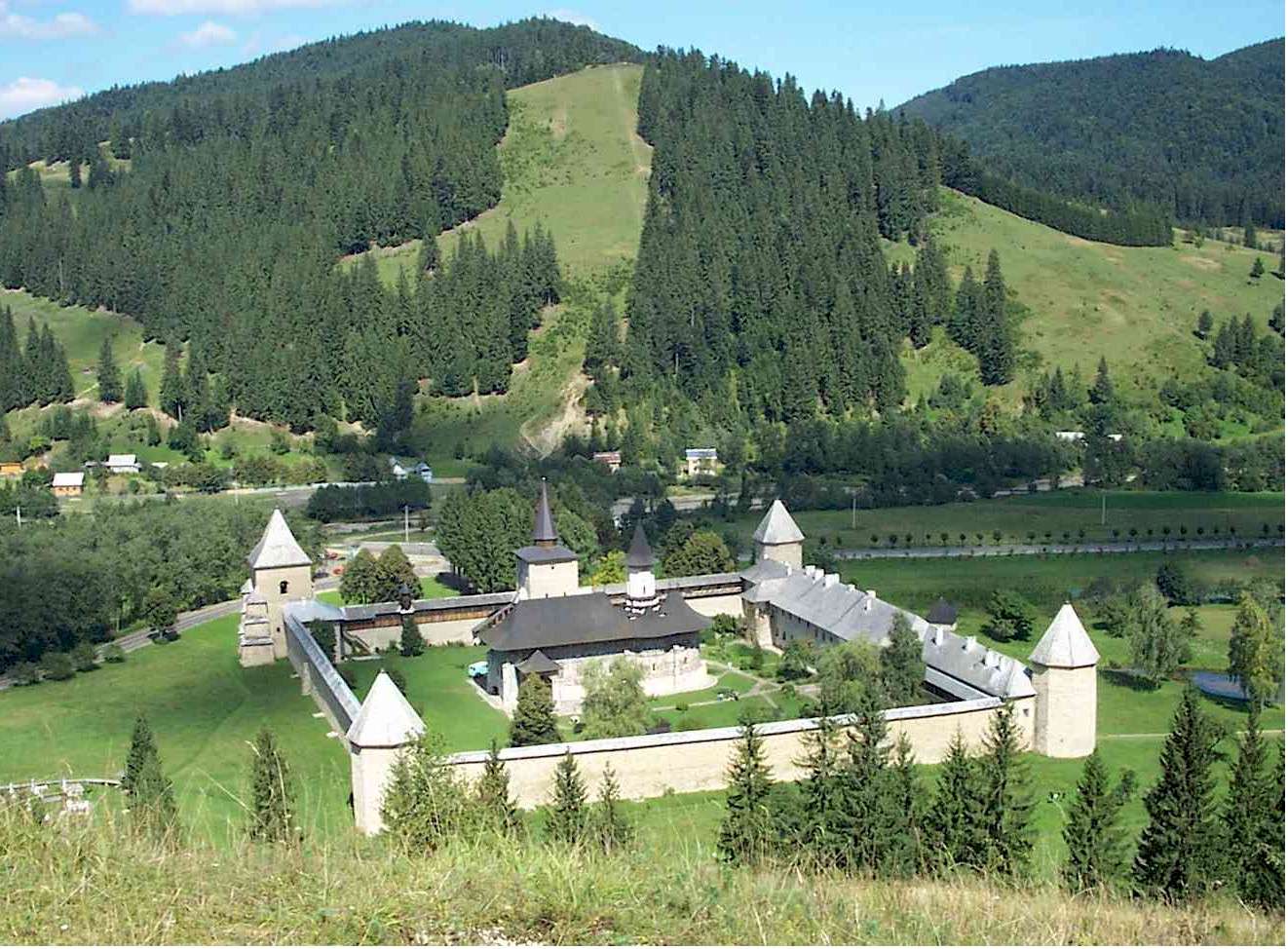 enriched them with art treasures long after their founding. In a
centuries-old practice found throughout the Balkans, such a monastery typically took the
form of a fortified enclosure with a church at its center, protected by thick walls and
entered through a great gate. The interior surface of the walls were lined with
storerooms, workshops, cells for the monks or nuns, refectory and kitchen; guests, goods
and treasure were similarly accommodated along the walls, while the local inhabitants
could take refuge within the defenses in times of trouble.
enriched them with art treasures long after their founding. In a
centuries-old practice found throughout the Balkans, such a monastery typically took the
form of a fortified enclosure with a church at its center, protected by thick walls and
entered through a great gate. The interior surface of the walls were lined with
storerooms, workshops, cells for the monks or nuns, refectory and kitchen; guests, goods
and treasure were similarly accommodated along the walls, while the local inhabitants
could take refuge within the defenses in times of trouble.
About a dozen painted monasteries dating from the second quarter of the sixteenth
century remain in Bucovina. Located within kilometers of each other, they are nevertheless
separated by narrow roads that wind over mountain passes and past scattered farmyards and
fertile pastures. The most remarkable are the monastic foundations at Humor
(hoo mor),
Moldoviţa (mol do vee' tsa), Arbore (are' bo ray) and Voroneţ (vo
ro nets). Suceviţa (sue che vee' tsa), dating from 1600, represents a
late return to the style developed some seventy years earlier. The tradition of painted
churches continued into the nineteenth century in other parts of Romania, although never
to the same extent. The painted monasteries show the influence of the Byzantine tradition
of the Byzantine artists active in Wallachia in the 14th and early 15th centuries, but
increasingly the artists were indigenous.
Bucovina is a region of continual rain in the spring and autumn, and it is buffeted by blizzards in winter. Violent winds from the steppes have damaged the northern side of the churches over the centuries, but the outer wall frescoes are generally admirably preserved. At one time it was thought that this permanence was due to plant pigments being mixed with egg yolk, which is fatty and therefore more waterproof than water and size. Recent studies find that the rich colors are based on harmonious combinations of a few tones derived from minerals – red ocher extracted from iron oxide clays; red from lead oxide; blue from unstable copper carbonate and in Voroneţ from lapis lazuli; green from basic copper carbonate; yellow ocher from clays rich in hydrated iron oxide. These pigments were mixed with lamp-black or charcoal to counteract the drawing action of the plaster. Other substances including animal size, vinegar, egg, gall and honey have been identified. Classic fresco technique was used, about four square meters or more being painted in a day's work. Details were added al secco, in particular on faces and in inscriptions, and gold leaf was sometimes added.
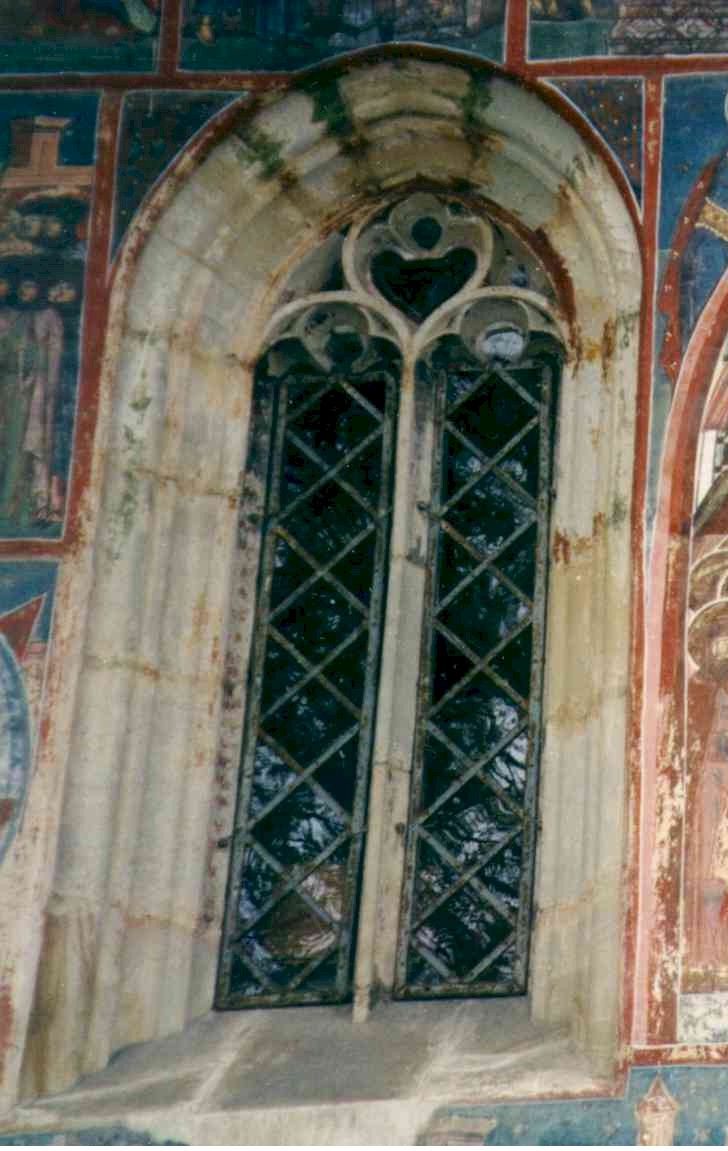 The Moldavian
churches differ from the cathedrals and great churches of Western Europe in having few
windows, and therefore less need for buttressing except where there is a steeple. If there
is any visible Gothic influence, it is only as a mere detail in the stone plinths,
doorways and window frames of the buildings. Designed for small congregations, they are
small and intimate. On holidays and feastdays, the neighboring population would attend
sevices, gathering outside the church within the monastery precinct. At Easter, a midnight
candlelit procession wound around the church.
The Moldavian
churches differ from the cathedrals and great churches of Western Europe in having few
windows, and therefore less need for buttressing except where there is a steeple. If there
is any visible Gothic influence, it is only as a mere detail in the stone plinths,
doorways and window frames of the buildings. Designed for small congregations, they are
small and intimate. On holidays and feastdays, the neighboring population would attend
sevices, gathering outside the church within the monastery precinct. At Easter, a midnight
candlelit procession wound around the church.
Most of the churches are divided into the four sections typical of Stephen the Great’s times: On the west side a porch, sometimes open, leads to the pronaos or narthex. A doorway opens from this to the naos or burial place, where the founder of the church is usually interred, with a tombstone beneath a low, vaulted ceiling; often, above the burial chamber is a treasury, accessible by means of a spiral stair built into the thickness of the wall. A second doorway leads to the nave, which is invariably trefoil in shape -- a symbol of the cross. The altar is situated in the eastern apse, which is closed off from the congregation, as in all Eastern Orthodox churches, by a wooden screen enriched with icons, the iconostasis. The origin of the plan is supposed to be Mount Athos and to have come to Wallachia, and hence to Moldavia, via Serbia. The trefoil plan is only found in the Mount Athos churches and hardly at all in the rest of Greece. All of the churches are active, and today photography is forbidden inside all the sanctuaries. Interior photos on this site were taken with permission.
Inside the churches, frescoes illustrating the lives of the saints and martyrs decorate
every inch of the walls and domed or vaulted ceilings. A portrait of the donor and his
family presenting a miniature version of the church usually appears to the right of the
door in the nave. These painted models are important historical records of the original
appearance of the monument. There are no chairs or pews in Orthodox churches, only
occasional choir stalls in the nave. The interiors are quite dark and usually a black film
of soot from centuries of incense burning and candlelit devotions further obscures the
frescoes. Today, the candles of the faithful have been banished to outdoor stalls and
efforts are made to clean the frescoes.
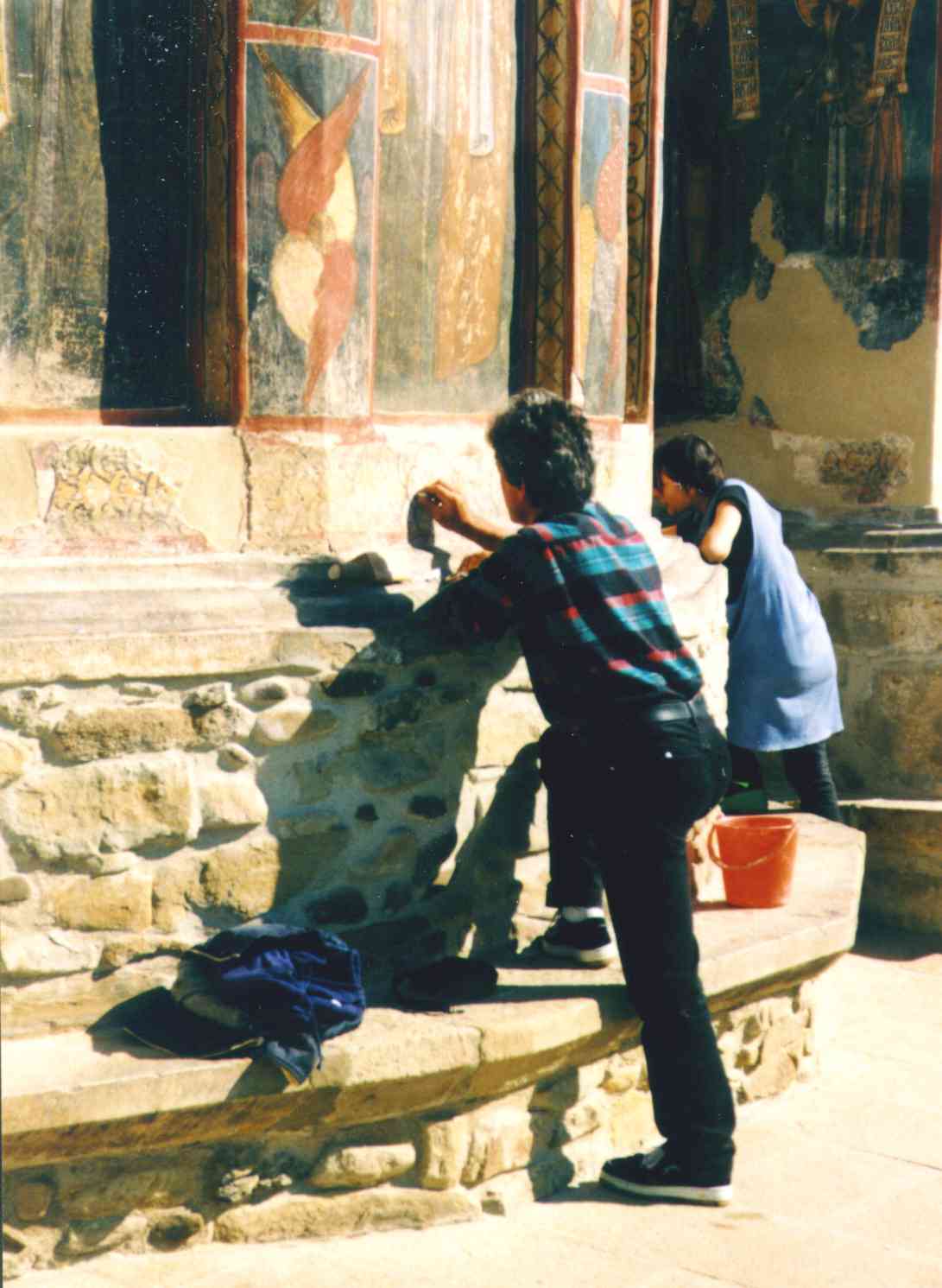 What is being done to preserve these unique treasures? They form part of Romania’s
rich heritage, of which she is rightly proud, and the importance of restoring and
conserving both the fabric and the frescoes is clearly recognized. Restoration efforts
were already undertaken in the second half of the nineteenth century. Modern efforts have
been sporadically undertaken since the mid 1950s, when UNESCO recognized
the unique quality of the painted monasteries by declaring seven of them protected cultural sites. Restoration of the
interior frescoes is largely confined to washing them, either in trial patches or more
extensive efforts. At Humor, the fir-shingled roof was rebuilt in the original style (but
with eaves widened to better protect the frescoes), the paintings of the pronaos and
burial chamber were cleaned, and the porch is being restored.
Less fortunate, Voroneţ is marred by a tin roof; the enclosure wall, which had largely
collapsed, has recently been restored, but this may have been a mistake since it seems to
be creating a humid micro-climate that is causing water damage in the bottom range
of frescoes. Restorers can only try to stabilize what is left.Work is sadly hampered by
lack of funds and the unavailability of skilled craftsmen. Scaffoldings everywhere in the
2001 season attest to ongoing efforts.
What is being done to preserve these unique treasures? They form part of Romania’s
rich heritage, of which she is rightly proud, and the importance of restoring and
conserving both the fabric and the frescoes is clearly recognized. Restoration efforts
were already undertaken in the second half of the nineteenth century. Modern efforts have
been sporadically undertaken since the mid 1950s, when UNESCO recognized
the unique quality of the painted monasteries by declaring seven of them protected cultural sites. Restoration of the
interior frescoes is largely confined to washing them, either in trial patches or more
extensive efforts. At Humor, the fir-shingled roof was rebuilt in the original style (but
with eaves widened to better protect the frescoes), the paintings of the pronaos and
burial chamber were cleaned, and the porch is being restored.
Less fortunate, Voroneţ is marred by a tin roof; the enclosure wall, which had largely
collapsed, has recently been restored, but this may have been a mistake since it seems to
be creating a humid micro-climate that is causing water damage in the bottom range
of frescoes. Restorers can only try to stabilize what is left.Work is sadly hampered by
lack of funds and the unavailability of skilled craftsmen. Scaffoldings everywhere in the
2001 season attest to ongoing efforts.
| Home | Humor | Moldoviţa | Arbore | Voroneţ | Suceviţa |
| Link | Pictures | Pictures | Pictures | Pictures | Pictures |